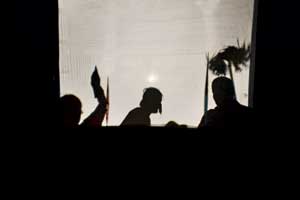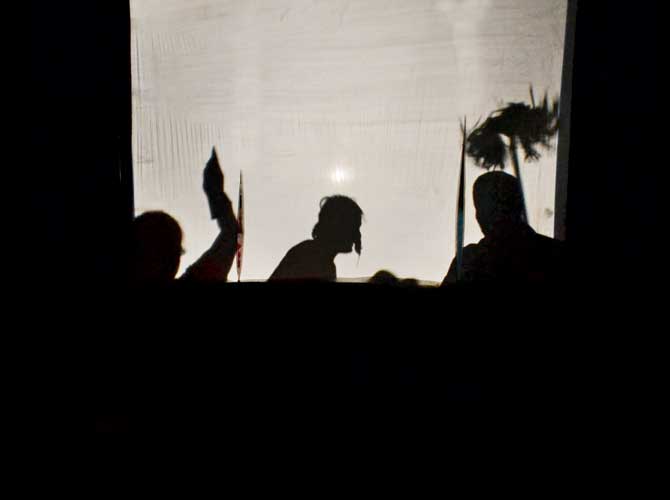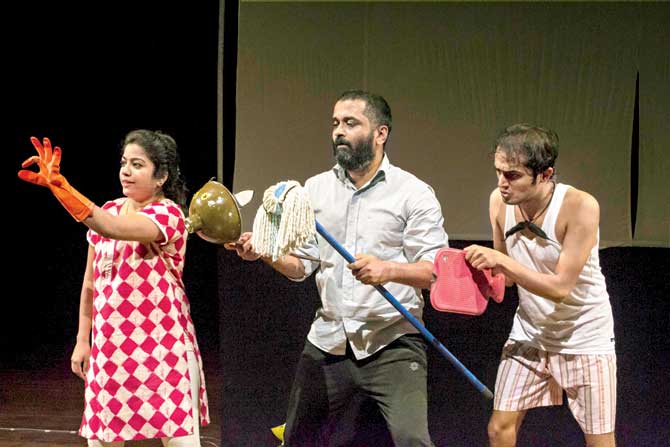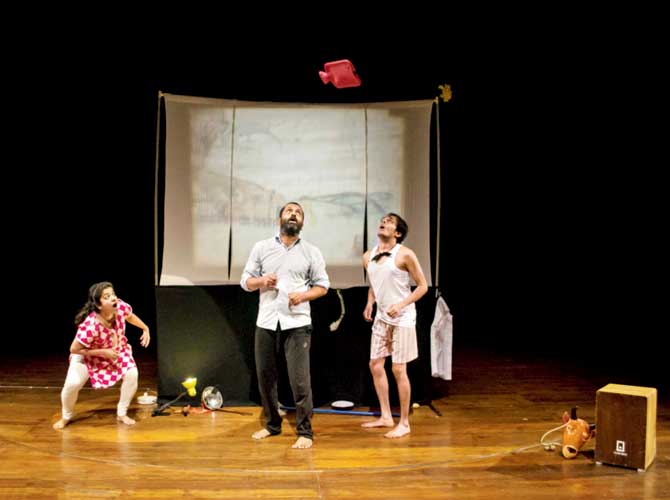Watch a bovine protagonist and other farm animals come alive through found objects, puppetry and imagery in a play that premieres in the city this week


Scenes from the play. pics/richa bhavanam
ADVERTISEMENT
In the world of classic children's literature, stories often end in a moral. While many of these lessons stand kids in good stead, life is far more complex to fit into templates. With its play, How Cow Now Cow, Bengaluru-based Sandbox Collective attempts to accord the audience the liberty to interpret the story as they see fit, without judgment. With over 100 shows staged across the country, from theatre festivals, schools to large auditoria and intimate spaces, the play makes its debut in Mumbai this week.
"It is the simple story of a cow in a farm that starts troubling the other residents. Such is the ruckus she creates that the farmer decides to send her away. Does her equation with the other animals change upon her return? This is something that we try to portray through a play of objects, shadows and music," says director Vinod Ravindran, who is also part of the cast, which includes Rency Philip/ Shweta Desai and Anirudh Mahesh. The play has been adapted from a German production.

Apart from the cow, which is represented by a papier-mache mask, all other characters are fashioned out of everyday objects — the fish, for instance, comes from a modified hot water bag, as does the dog, which is crafted out of a mop. "Instead of showing you something that is obvious, where there is hardly any space for negotiation, isn't it better to have a collaborative approach between the actors and the audience?" shares Ravindran. "While there may be a kid or two who would say, 'This can't be a dog; this is a mop', transforming objects is how children play," adds Philip.
While both Ravindran and Philip refrain from boiling the play down to one underlying message, Philip shares that in her eyes the play is about the many kinds of people we come across in life, and how we find friendship both in spite of and because of their quirks and foibles.
It is because of such universal themes that the play strikes a chord with adults too. "There are times when parents have watched it with kids, or have brought their children to a show after having first watched it by themselves. The ushers often get confused about the age group of the audience!" chuckles Ravindran.

But some of the best responses tend to come from kids, perhaps because they are the most open to ideas and their judgment has still not been tinged with the concerns of grown-ups. "A young girl once came up to us at the end of a performance and asked how the three of us agreed over what each of us does in the play. Because when she did a project with her classmates, reaching a consensus was the toughest part," recalls Ravindran. "Kids slowly start processing what they saw, and come back with amazing observations."
ON May 24, 25, 12 noon and 4 pm
AT Prithvi Theatre, Juhu. LOG ON TO bookmyshow.com COST Rs 250
All about the world of object theatre
What sets apart object theatre from the conventional form of staging a play is the fact that objects, instead of being in the background as props to complement the plot, become the main characters themselves. This shift from a human-centric approach to theatre dates back to the beginning of the 20th century, where avant-garde artistes such as Filippo Tommaso Marinetti and Vladimir Mayakovsky literally breathed life into inanimate objects, dethroning the actor as the central character of a play. Object theatre gained popularity in the 1980s, especially among puppeteers as a no-frills method of art-making. It is also popular among other performance arts.
Catch up on all the latest Crime, National, International and Hatke news here. Also, download the new mid-day Android and iOS apps to get latest updates
 Subscribe today by clicking the link and stay updated with the latest news!" Click here!
Subscribe today by clicking the link and stay updated with the latest news!" Click here!






